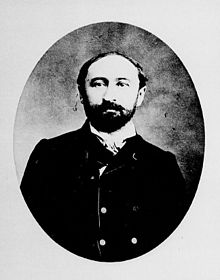Eugène Müntz
Eugène Müntz (born June 11, 1845 in Soultz-sous-Forêts near Mulhouse , Alsace , † October 30, 1902 in Paris ) was a French art historian . He was a professor and librarian at the École des Beaux-Arts in Paris.
Life
Müntz first began to study law in Paris, but then turned to art criticism and art history. He first attracted attention through articles in the Alsacienne Revue . From 1875 studied at the École française de Rome, founded two years earlier, with Albert Dumont . He acquired a comprehensive knowledge of Italian art and architecture in the Vatican archives and through observation on site in Rome. His first work in 1875 was dedicated to the role of the Popes in promoting art in the Renaissance. In 1876 he became librarian and archive manager at the Ecole des Beaux-Arts in Paris. From 1885 to 1892 he also took over the chair for aesthetics from Hippolyte Taine .
He dealt in particular with the Italian Renaissance , among other things he wrote a biography of Raphael and Leonardo da Vinci . He found recognition especially through his biography of Raphael and in France through his overall presentation of the art of the Renaissance (1888-1894), with the focus of his studies in Rome and Florence of the High Renaissance. He also published on Roman and early Christian art and contemporary art, on the collections of the Medici and the Popes in Avignon.
His writings are primarily of a descriptive and documentary nature, based on a precise knowledge of the existing documents. In an 1884 paper about Raphael in art history and art criticism, he turned against the trend towards specialized art connoisseurs , for which Giovanni Morelli stood at the time . He was also critical of the positivist approach of his colleague at the École des beaux-arts Hippolyte Taine . In Italy at the same time Gaetano Milanesi undertook similar pioneering work on historical sources on the history of art of the Renaissance. Müntz tried to combine the different areas of arts and crafts and also dealt with furniture, ceramics, carvings and wallpaper, for example. Most recently he dealt with the influence of the Italian Renaissance in the rest of Europe, starting with France. His death prevented further planned studies here.
From 1888 on, Müntz was a corresponding member of the Bavarian Academy of Sciences .
Fonts
- Notes sur les mosaïques de l'Italie , 1874–92
- Les arts à la cour des papes pendant le XVe et le XVIe siècle , 4 volumes, 1878–1898
- Les précurseurs de la Renaissance , 1881
- Raphaël, sa vie, son œuvre et son temps , 1881, 2nd edition 1886
- Histoire de la tapisserie , 1882
- Etudes sur l'histoire de la peinture et de l'iconographie chrétiennes , 1882
- Les Historiens et les critiques de Raphael , 1884
- Histoire de l'art pendant la Renaissance , 3 volumes, 1888-1894, volume 1: Les Primitifs , 1888; Volume 2: L'Age d'Or , 1891, Volume 3: La Fin de la Renaissance , 1895
- Léonard da Vinci, l'artiste, le penseur, le savant , 1899
- Etudes iconographiques et archéologiques sur le Moyen-Age , 1888
- Donatello , 1885
- Le Palais des papes à Avignon , 1886 to 1892
- with P. Fabre: La Bibliothèque du Vatican au XVIe siècle , 1887
- Collections des Médicis au XVe siècle , 1887
- Antiquités de Rome au XIVe, XVe et XVIe siècles , 1887
- Florence et la Toscane , 1897
- La Tiare Pontificale du VIIIe siècle au XVIe siècle , 1897
- La Renaissance en Italie et en France à l'époque de Charles VIII , 1885
- with Émile Molinier: Le Château de Fontainebleau au XVie siècle , 1886
literature
- Louis Gillet: Eugène Müntz , in: Catholic Encyclopedia . Vol. 10. Robert Appleton Company, New York 1911
Web links
- Dictionary of Art Historians
- Literature by and about Eugène Müntz in the SUDOC catalog (Association of French University Libraries)
Individual evidence
- ^ Eugéne Müntz , members of the Bavarian Academy of Sciences
| personal data | |
|---|---|
| SURNAME | Müntz, Eugène |
| BRIEF DESCRIPTION | French art historian |
| DATE OF BIRTH | June 11, 1845 |
| PLACE OF BIRTH | Soultz-sous-Forêts |
| DATE OF DEATH | October 30, 1902 |
| Place of death | Paris |
